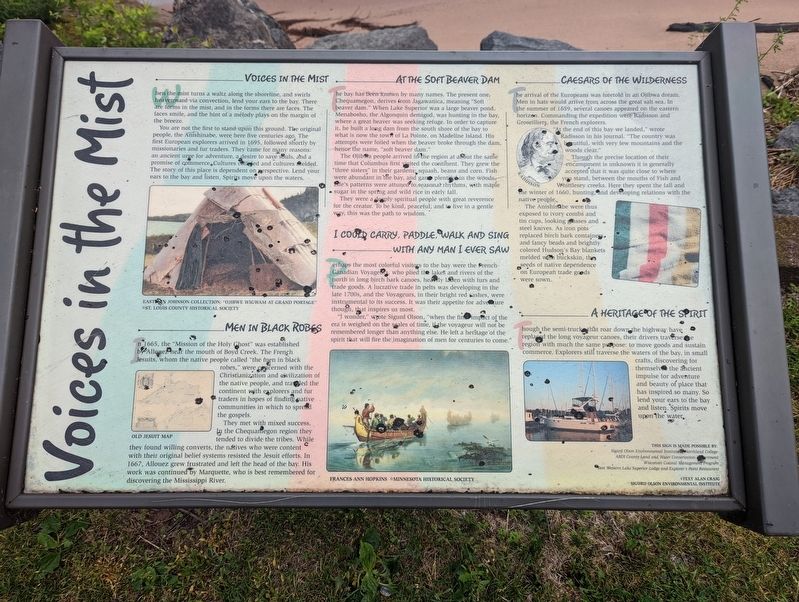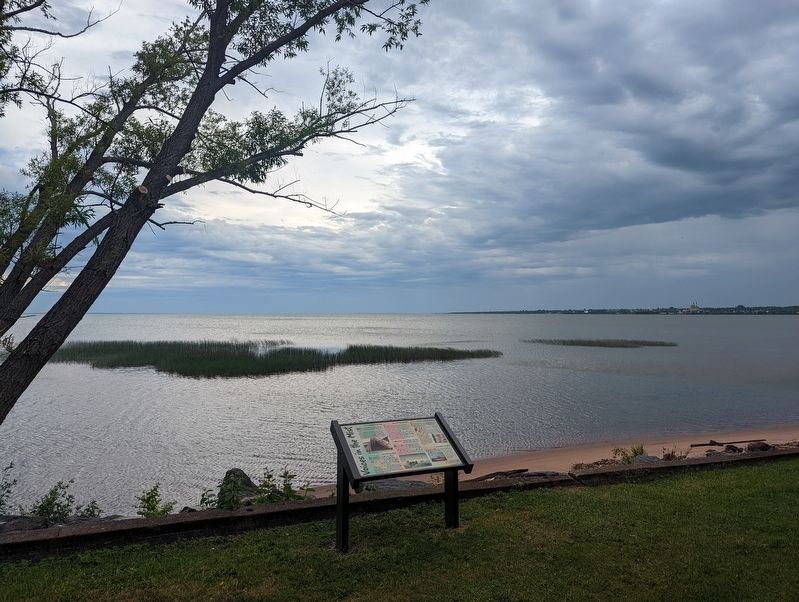Near Ashland in Bayfield County, Wisconsin — The American Midwest (Great Lakes)
Voices in the Mist
When the mist turns a waltz along the shoreline, and swirls heavenward via convection, lend your ears to the bay. There are forms in the mist, and in the forms there are faces. The faces smile, and the hint of a melody plays on the margin of the breeze.
You are not the first to stand upon this ground. The original people, the Anishinabe, were here five centuries ago. The first European explorers arrived in 1695, followed shortly by missionaries and fur traders. They came for many reasons: an ancient urge for adventure, a desire to save souls, and a promise of commerce. Cultures collided and cultures melded. The story of this place is dependent on perspective. Lend your ears to the bay and listen, Spirits move upon the waters.
MEN IN BLACK ROBES
In 1665, the "Mission of the Holy Ghost” was established by Allouez near the mouth of Boyd Creek. The French Jesuits, whom the native people called "the men in black robes,” were concerned with the Christianization and civilization of the native people, and traveled the continent with explorers and fur traders in hopes of finding native communities in which to spread the gospels.
They met with mixed success. In the Chequamegon region they tended to divide the tribes. While they found willing converts, the natives who were content with their original belief systems resisted the Jesuit efforts. In 1667, Allouez grew frustrated and left the head of the bay. His work was continued by Marquette, who is best remembered for discovering the Mississippi River.
AT THE SOFT BEAVER DAM
The bay has been known by many names. The present one, Chequamegon, derives from Jagawanica, meaning "Soft beaver dam.” When Lake Superior was a large beaver pond, Menabosho, the Algonquin demigod, was hunting in the bay, where a great beaver was seeking refuge. In order to capture it, he built a long dam from the south shore of the bay to what is now the town of La Pointe, on Madeline Island. His attempts were foiled when the beaver broke through the dam, hence the name, "soft beaver dam."
The Ojibwa people arrived in the region at about the same time that Columbus first visited the continent. They grew the "three sisters” in their gardens: squash, beans and corn. Fish were abundant in the bay, and game plentiful in the woods. Life's patterns were attuned to seasonal rhythms, with maple sugar in the spring and wild rice in early fall.
They were a deeply spiritual people with great reverence for the creator. To be kind, peaceful, and to live in a gentle way, this was the path to wisdom.
I COULD CARRY, PADDLE, WALK AND SING WITH ANY MAN I EVER SAW
Perhaps the most colorful visitors to the bay were the French-Canadian Voyageurs, who plied the lakes and rivers of the north in long birch bark canoes, heavily laden with furs and trade goods. A lucrative trade in pelts was developing in the late 1700s, and the Voyageurs, in their bright red sashes, were instrumental to its success. It was their appetite for adventure though, that inspires us most.
"I wonder,” wrote Sigurd Olson, "when the final impact of the era is weighed on the sales of time, if the voyageur will not be remembered longer than anything else. He left a heritage of the spirit that will fire the imagination of men for centuries to come."
CAESARS OF THE WILDERNESS
The arrival of the Europeans was foretold in an Ojibwa dream. Men in hats would arrive from across the great salt sea. In the summer of 1659, several canoes appeared on the eastern horizon. Commanding the expedition were Radisson and Groseilliers, the French explorers.
"At the end of this bay we landed,” wrote Radisson in his journal. "The country was beautiful, with very few mountains and the woods clear."
Though the precise location of their encampment is unknown it is generally accepted that it was quite close to where you stand, between the mouths of Fish and Whittlesey creeks. Here they spent the fall and the winter of 1660, hunting, and developing relations with the native people.
The Anishinabe were thus exposed to ivory combs and tin cups, looking gasses and steel knives. As iron pots replaced birch bark containers, and fancy beads and brightly colored Hudson's Bay blankets melded with buckskin, the seeds of native dependence on European trade goods were sown.
A HERITAGE OF THE SPIRIT
Though the semi-trucks that roar down the highway have replaced the long voyageur canoes, their drivers traverse the region with much the same purpose: to move goods and sustain commerce. Explorers still traverse the waters of the bay, in small crafts, discovering for themselves the ancient impulse for adventure and beauty of place that has inspired so many. So lend your ears to the bay and listen. Spirits move upon the water.
Erected by Sigurd Olson Environmental Institute of Northland College, ABDI County Land and Water Conservation Department, Wisconsin Coastal Management Program, Best Western Lake Superior Lodge and Explorer's Point Restaurant.
Topics. This historical marker is listed in these topic lists: Environment • Exploration • Native Americans • Waterways & Vessels. A significant historical year for this entry is 1695.
Location. 46° 35.24′ N, 90° 56.182′ W. Marker is near Ashland, Wisconsin, in Bayfield County. Located behind the Quality Inn Ashland-Lake Superior. Touch for map. Marker is at or near this postal address: 30600 US Highway 2, Ashland WI 54806, United States of America. Touch for directions.
Other nearby markers. At least 8 other markers are within 6 miles of this marker, measured as the crow flies. Lands Along the Lake (within shouting distance of this marker); Radisson-Groseilliers Fort (approx. 0.9 miles away); Security Savings Bank (approx. 2.4 miles away); Doctor Edwin Ellis (approx. 3 miles away); Northland College (approx. 3.1 miles away); Schooner Lucerne (approx. 3½ miles away); Fleet Admiral William D. Leahy (approx. 3.6 miles away); The Sprague Well (approx. 5.7 miles away). Touch for a list and map of all markers in Ashland.
Credits. This page was last revised on July 5, 2022. It was originally submitted on July 5, 2022, by Mike Wintermantel of Pittsburgh, Pennsylvania. This page has been viewed 118 times since then and 19 times this year. Photos: 1, 2. submitted on July 5, 2022, by Mike Wintermantel of Pittsburgh, Pennsylvania.

